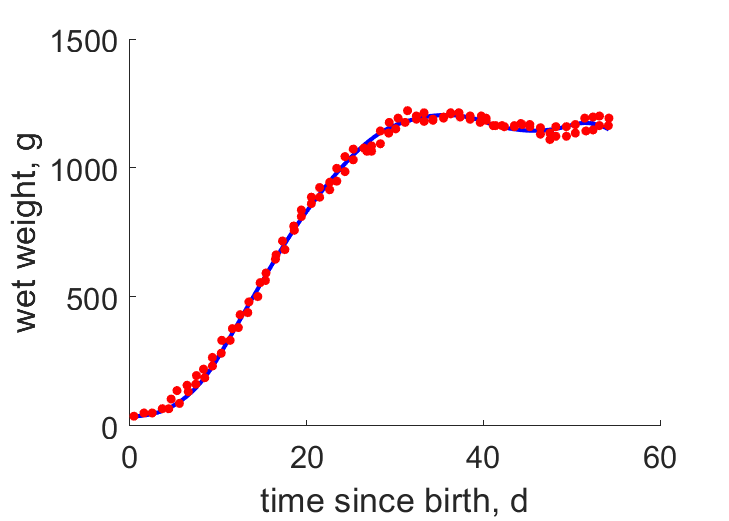Predictions & Data for this entry
| Model: std | climate: BWh, BSk | migrate: Ms | phylum: |
| COMPLETE = 2.5 | ecozone: THp | food: biCi, biCvr | class: |
| MRE = 0.006 | habitat: 0iTs, 0iTa, 0iTd | gender: Dg | order: |
| SMSE = 0.000 | embryo: Tncfm | reprod: O | family: |
Zero-variate data
| Data | Observed | Predicted | (RE) | Unit | Description | Reference |
|---|---|---|---|---|---|---|
| ab | 24.5 | 24.64 | (0.005685) | d | age at birth | TintKotr2002 |
| tx | 45 | 44.92 | (0.001692) | d | time since birth at fledging | TintKotr2002 |
| tp | 135 | 135.4 | (0.002749) | d | time since birth at puberty | guess |
| tR | 1095 | 1095 | ( 0) | d | time since birth at 1st brood | Wiki |
| am | 1.201e+04 | 1.204e+04 | (0.00245) | d | life span | AnAge |
| Wwb | 37 | 36.93 | (0.001781) | g | wet weight at birth | TintKotr2002 |
| Wwi | 1202 | 1205 | (0.002884) | g | ultimate wet weight for females | AnAge |
| Ri | 0.008219 | 0.008235 | (0.001877) | #/d | maximum reprod rate | Wiki |
Uni- and bivariate data
| Data | Figure | Independent variable | Dependent variable | (RE) | Reference |
|---|---|---|---|---|---|
| tW |  | time since birth | wet weight | (0.02037) | TintKotr2002 |
Pseudo-data at Tref = 20°C
| Data | Generalised animal | Geronticus eremita | Unit | Description |
|---|---|---|---|---|
| v | 0.02 | 0.03762 | cm/d | energy conductance |
| p_M | 18 | 667.3 | J/d.cm^3 | vol-spec som maint |
| k_J | 0.002 | 0.02736 | 1/d | maturity maint rate coefficient |
| k | 0.3 | 0.3001 | - | maintenance ratio |
| kap | 0.8 | 0.962 | - | allocation fraction to soma |
| kap_G | 0.8 | 0.8003 | - | growth efficiency |
| kap_R | 0.95 | 0.95 | - | reproduction efficiency |
Discussion
- scaled functional response turned out to vary, which has been implemented
- mod_1: Pseudo-data point k is used, rather than k_J; Data set tp and parameter t_R are added, the latter replacing clutch interval t_N. Postnatal T is based on PrinPres1991, see get_T_Aves. See further the revision page, theme puberty
Facts
- Males are generally larger than females (Ref: Wiki)
- Group-raised individuals grew faster, but to the same ultimate wieght (Ref: TintKotr2002)
Bibliography